|
The FilmStar Workbook is a spreadsheet
module built into DESIGN and
MEASURE. Utilizing familiar spreadsheet syntax, it provides a powerful
programmable interface for analyzing and optimizing spectral response.
|
|
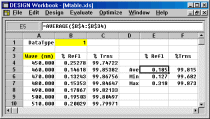
FilmStar Workbook for
Average/Maximum %T & %R
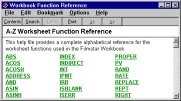
On-line Function Reference
|
Introducing the Workbook
Once a spectrum is calculated or scanned a single click or keyboard
shortcut pops-up the workbook and
transfers the new spectrum. Multiple spectra can be inserted into adjacent columns.
Formulas are virtually identical to those in Microsoft Excel.
Since the workbook includes macro capabilities, it can serve as an
alternative FilmStar front end with the spreadsheet paradigm replacing
the normal spectral plot. This is useful for evaluating and optimizing
coatings when integrated performance is defined without reference to a
particular spectral shape.
|
|
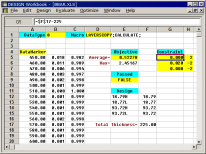
Optimization using Generalized
Merit Function and Constraints
(4 layer AR with unusual
thickness constraints)
|
Optimization in DESIGN
Supplementing DESIGN's traditional optimization target list, FilmStar
supports generalized merit functions and constraints for meeting system performance
requirements. Constraints such as total layer
thickness or stress can be included. These capabilities are not available in
other optical thin film software.
Essentially, a spreadsheet cell is treated as a merit
function and a group of cells defines constraints. Since these cells can be general
functions of multiple spectra and/or layer thickness there are many options.
Most importantly for active devices such as solar cells, integrated absorption
in specified layers can be optimized.
|
|
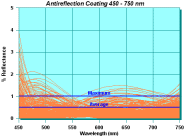
5% Coating Errors
(but what's the % yield?)
|
Tolerancing
uses Monte Carlo techniques to estimate coating yields. Graphically, errors affects
coating performance as shown here.
But we don't know the yield from looking at the graph. Workbook tolerancing provides a way to estimate yields. The
workbook is set up so that named cell Passed
($E$9)
has value TRUE or
FALSE depending on
whether the coating passes or fails the specification. Assuming that the average cannot
exceed 0.5% over the range 450-750 nm and the maximum cannot exceed 1%, the following
formulas are all that is required:
$E$9 =AND($E$5<0.5,$E$6<1)
$E$5 =100*AVERAGE($B$5:$B$35)
$E$6 =100*MAX($B$5:$B$35)
Here's the results (100 iterations at each error level):
2% -> 100% yield
4% -> 73%
6% -> 51%
etc.
Tolerancing can also be performed under FilmStar BASIC control. This
might be appropriate when independent layer errors are insufficient to describe the
situation or when pass/fail criteria are exceedingly complex.
|
|
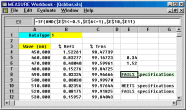
Quality Control Calculation
|
Quality Control in MEASURE
The MEASURE workbook is virtually
identical to the one in DESIGN and shares the same source code. The model shown
here is
used in the example in the Report Generator page.
Essentially, the same workbook model used for design tolerancing is used for quality
control. The only difference is that a pass/fail label like MEETS specifications
is generated instead of percent yield.
|





